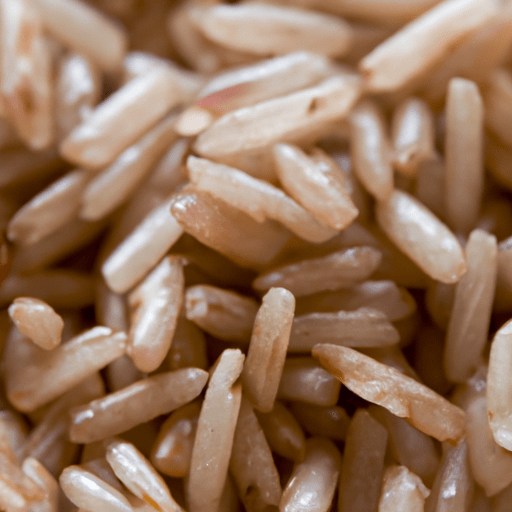Cooking with Long-Grain Brown Rice: A Nutty and Nutritious Delight
Long-grain brown rice is a staple in many kitchens, loved for its nutty flavor, versatile nature, and impressive health benefits. Whether you’re a seasoned cook or a novice in the kitchen, this grain deserves a spot in your pantry. In this blog post, we’ll explore the wonderful world of long-grain brown rice, from its taste and common uses to its nutritional value and fascinating history.
Nutty Flavor and Texture
Unlike its polished white counterpart, long-grain brown rice retains the outer bran layer, giving it a brown hue and a slightly chewy texture. It is this bran layer that holds an abundance of flavor, providing a nutty and earthy taste that adds depth to any dish. Some even describe its flavor as being reminiscent of popcorn or roasted nuts. So, if you’re looking to elevate your recipes with a unique taste, long-grain brown rice is an excellent choice.
Versatility in the Kitchen
Long-grain brown rice is incredibly versatile and can be incorporated into various cuisines and culinary styles. Its grains remain separate and loose after cooking, making it an ideal choice for pilafs, stir-fries, and rice salads. The slightly chewy texture also makes it a great option for stuffing vegetables or adding to hearty soups. Its neutral taste allows it to absorb the flavors of spices, herbs, and sauces, making it a perfect canvas for creativity in the kitchen.
Nutritional Powerhouse
Beyond its delectable taste, long-grain brown rice also packs a nutritional punch. It is a fantastic source of essential nutrients, including fiber, magnesium, phosphorus, and B-vitamins. The bran layer in brown rice contains fiber, which aids digestion and promotes a feeling of fullness. Additionally, the magnesium found in this grain contributes to the maintenance of healthy bones and energy metabolism. Incorporating long-grain brown rice into your meals is an excellent way to nourish your body with wholesome goodness.
Rich History and Interesting Facts
Long-grain brown rice has a rich history dating back centuries. Native to Asia, it was cultivated in ancient China as early as 2500 BCE. Over time, it spread to other regions, becoming a dietary staple in many cultures worldwide. In fact, in some Asian countries, long-grain brown rice is considered a symbol of abundance and prosperity.
It’s also interesting to note that long-grain rice is a close cousin to the aromatic basmati and jasmine rices. While each variety has its unique characteristics, they all share a common allure and versatility in the kitchen.
Cooking Tips and Tricks
To prepare delicious long-grain brown rice, start by rinsing it under cold water to remove any excess starch. Then, combine one part rice with two parts water in a saucepan and bring to a boil. Reduce the heat to low, cover, and let it simmer for about 40-45 minutes until the grains are tender and fluffy. Resting the rice for a few minutes after cooking allows it to further steam and become even more delightful.
Fun Fact: Instant Pot Method
If you’re looking for an effortless and time-saving alternative, consider using an Instant Pot. Simply add the rinsed long-grain brown rice and water to the pot, set it to manual mode, and cook for around 22-25 minutes. Allow the pressure to release naturally for approximately 10 minutes before opening the lid. Voila! Perfectly cooked long-grain brown rice in a fraction of the time.
Long-grain brown rice is a culinary gem, offering a delightful nutty taste, incredible versatility, and a plethora of health benefits. Whether you’re aiming to create aromatic pilafs, vibrant rice salads, or wholesome one-pot meals, this grain is a reliable companion in the kitchen. So, head to your pantry, grab a bag of long-grain brown rice, and embark on a flavorful culinary adventure. Your taste buds and body will thank you!
Remember, cooking is an art, so don’t be afraid to experiment and create your own unique recipes using long-grain brown rice. The options are endless, and the satisfaction is guaranteed. Happy cooking!
Origin: Cooked long-grain brown rice is believed to have originated in Southeast Asia, particularly in regions like Thailand, Cambodia, and Vietnam. It has a history dating back thousands of years and has been a staple food in many Asian cultures.
Common Uses: Cooked long-grain brown rice is extremely versatile and can be used in various dishes. It is often served as a side dish, used in stir-fries, fried rice, pilafs, and even used to make rice salads and soups. Due to its slightly nutty flavor and chewy texture, it pairs well with a wide range of ingredients and cuisines.
Nutritional Benefits: Cooked long-grain brown rice is considered a highly nutritious food. It is an excellent source of complex carbohydrates, providing sustained energy. It is also a good source of dietary fiber, which aids in digestion. Additionally, it contains essential minerals such as magnesium, phosphorus, and selenium, as well as B-complex vitamins.
Unique Properties: One of the unique properties of cooked long-grain brown rice is its outer bran layer, which gives it a chewy texture and distinctive nutty flavor. Unlike white rice, which has been stripped of its bran and germ layers, brown rice retains these nutritious layers, making it more wholesome and nutritious.
Historical Significance: In many cultures, rice has played a significant role throughout history. It has been a major agricultural crop, forming the basis of many civilizations and diets. For example, in ancient China, rice cultivation was instrumental in fostering settled communities and contributing to cultural and technological advancements. Today, rice continues to hold cultural significance in many countries around the world.




Use the share button below if you liked it.
It makes me smile, when I see it.